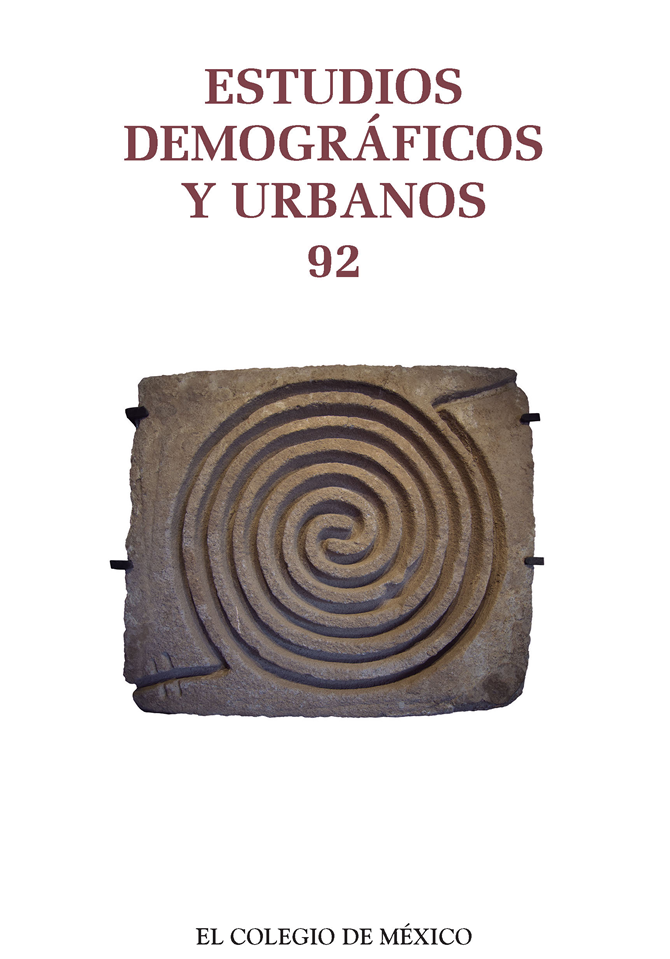Revisando los métodos de agregación de unidades espaciales: MAUP, algoritmos y un breve ejemplo
Publicado 2016-05-01
Palabras clave
- agregación espacial,
- algoritmos computacionales,
- MAUP,
- problema de unidad de área modificable
Cómo citar
-
Resumen1558
-
PDF (español)1782
-
En línea (español)3904
Descargas
Derechos de autor 2016 Estudios Demográficos y Urbanos

Esta obra está bajo una licencia internacional Creative Commons Atribución-NoComercial-SinDerivadas 4.0.
Métrica
Resumen
Los métodos de agregación espacial han generado interés en los últimos años debido a su fácil adecuación a diferentes objetivos. Más allá de eso existen razones estadísticas para aconsejar su aplicación: reducen el sesgo generado por el problema de unidad de área modificable (MAUP). En este artículo se presenta una revisión bibliográfica de este problema y de los diferentes métodos de agregación, así como la aplicación de un algoritmo a datos de la Zona Metropolitana del Valle de México.
Referencias
- Aerts, Jeroen y Gerard Heuvelink (2002), “Using simulated annealing for resource allocation”, International Journal of Geographical Information Science, vol. 16, núm. 6, pp. 571-587. Disponible en: http://www.tandfonline.com/doi/abs/10.1080/13658810210138751 (27 de mayo de 2014). DOI: https://doi.org/10.1080/13658810210138751
- Aguilar, Adrián y Pablo Mateos (2011), “Diferenciación sociodemográfica del espacio urbano de la Ciudad de México”, Eure, vol. 37, núm. 110, pp. 5-30. Disponible en: http://www.scielo.cl/pdf/eure/v37n110/art01.pdf (9 de junio de 2014). DOI: https://doi.org/10.4067/S0250-71612011000100001
- Aguilar, Adrián y Peter Ward (2003), “Globalization, regional development, and mega-city expansion in Latin America: analyzing Mexico City’s peri-urban hinterland”, Cities, vol. 20, núm. 1, pp. 3-21. Disponible en: http://www.sciencedirect.com/science/article/pii/S0264275102000926 (9 de junio de 2014). DOI: https://doi.org/10.1016/S0264-2751(02)00092-6
- Andersson, Martin y Urban Grasjö (2009), “Spatial dependence and the representation of space in empirical models”, The Annals of Regional Science, vol. 43, núm. 1, pp. 159-180. Disponible en: http://link.springer.com/article/10.1007%2Fs00168-008-0211-5#/page-1 (14 de noviembre de 2013). DOI: https://doi.org/10.1007/s00168-008-0211-5
- Anselin, Luc (1988), “The formal expression of spatial effects”, en Luc Anselin, Spatial Econometrics: Methods and Models, Boston, Kluwer Academic Publishers, pp. 16-31. DOI: https://doi.org/10.1007/978-94-015-7799-1_3
- Anselin, Luc (1999), “Spatial econometrics”, documento de trabajo, Bruton Center, School of Social Sciences, University of Texas. Disponible en: http://www.csiss.org/learning_resources/content/papers/baltchap.pdf (27 de mayo de 2014).
- Ariza, Marina y Patricio Solís (2009), “Dinámica socioeconómica y segregación espacial en tres áreas metropolitanas de México, 1990 y 2000”, Estudios Sociológicos, vol. 27, núm. 79, pp. 171-209. Disponible en: http://www.redalyc.org/articulo.oa?id=59820689006 (16 de febrero de 2014). DOI: https://doi.org/10.24201/es.2009v27n79.266
- Armstrong, Marc, Panos Lolonis y Rex Honey (1993), “A spatial decision support system for school redistricting”, Journal of the Urban and Regional Information Systems Assoociation, vol. 5, pp. 40-52. Disponible en: https://www.researchgate.net/publication/255782392_A_spatial_decision_support_systemfor_school_redistricting (27 de mayo de 2014).
- Bergey, Paul, Cliff Ragsdale y Mangesh Hoskote (2003), “A simulated annealing genetic algorithm for the electrical power districting problem”, Annals of Operations Research, vol. 121, núm. 1-4, pp. 33-55. Disponible en: http://link.springer.com/article/10.1023%2FA%3A1023347000978#/page-1 (16 de febrero de 2014).
- Bozkaya, Burcin, Erhan Erkut y Gilbert Laporte (2003), “A tabu search heuristic and adaptive memory procedure for political districting”, European Journal of Operational Research, vol. 144, núm. 1, pp. 12-26. Disponible en: http://www.sciencedirect.com/science/article/pii/S0377221701003800 (13 de septiembre de 2013). DOI: https://doi.org/10.1016/S0377-2217(01)00380-0
- Brody, Howard, Michael Russell, Peter Vinten-Johansen, Nigel Paneth y Stephen Rachman (2000), “Map-making and myth-making in broad street: The London cholera epidemic, 1854”, The Lancet, núm. 356, pp. 64-68. Disponible en: http://www.uio.no/studier/emner/matnat/ifi/INF5761/v12/undervisningsmateriale/map_making_myth_making%281%29.pdf (9 de junio de 2014). DOI: https://doi.org/10.1016/S0140-6736(00)02442-9
- Chiquiar, Daniel (2005), “Why Mexico’s regional income covergence broke down?”, Journal of Development Economics, vol. 77, núm. 1, pp. 257-275. Disponible en: http://www.sciencedirect.com/science/article/pii/S0304387804001580 (13 de septiembre de 2013). DOI: https://doi.org/10.1016/j.jdeveco.2004.03.009
- D’Amico, Steven, Shoou-Jiun Wang, Rajan Batta y Christopher Rump (2002), “A simulated annealing approach to police districting design”, Computer and Operations Research, vol. 29, núm. 6, pp. 667-684. Disponible en: http://www.sciencedirect.com/science/article/pii/S0305054801000569 (14 de noviembre de 2013). DOI: https://doi.org/10.1016/S0305-0548(01)00056-9
- Delgadillo, Javier y Felipe Torres (2011), Estudios regionales en México: aproximaciones a las obras y sus autores, México, Instituto de Investigaciones Económicas, Universidad Nacional Autónoma de México.
- Duque Cardona, Juan Carlos (2004), “Design of homogenous territorial units. A methodological proposal and applications”, tesis de doctorado en Estudios Empresariales, Barcelona, Departamento de Econometría Estadística y Economía Española, Universidad de Barcelona.
- Duque, Juan Carlos, Manuel Artís y Raúl Ramos (2006), “The ecological fallacy in a time series context: Evidence from Spanish regional unemployment rates”, Journal of Geographic Systems, vol. 8, núm. 4, pp. 391-410. Disponible en: http://link.springer.com/article/10.1007%2Fs10109-006-0033-x#/page-1 (27 de mayo de 2014). DOI: https://doi.org/10.1007/s10109-006-0033-x
- Duque, Juan Carlos, Raúl Ramos y Jordi Suriñach (2007), “Supervised regionalization methods: a survey”, International Regional Science Review, vol. 30, núm. 3, pp. 195-220. Disponible en: http://irx.sagepub.com/content/30/3/195.full.pdf+html (9 de junio de 2014). DOI: https://doi.org/10.1177/0160017607301605
- Duque, Juan Carlos, Luc Anselin y Sergio Rey (2012), “The Max-P regions problem”, Journal of Regional Science, vol. 52, núm. 3, pp. 397-419. Disponible en: http://onlinelibrary.wiley.com/doi/10.1111/j.1467-9787.2011.00743.x/epdf (14 de noviembre de 2014). DOI: https://doi.org/10.1111/j.1467-9787.2011.00743.x
- Duque, Juan Carlos, Vicente Royuela y Miguel Noreña (2012), “A stepwise procedure to determinate a suitable scale for the spatial delimitation of urban slums”, en Esteban Fernández y Fernando Rubiera (coords.), Defining the Spatial Scale in Modern Regional Analysis, Oviedo-Berlín, Springer / Heidelberg, pp. 237-254. DOI: https://doi.org/10.1007/978-3-642-31994-5_12
- Esquivel, Gerardo (1999), “Convergencia regional en México, 1940-1995”, El Trimestre Económico, vol. 66, núm. 264, pp. 725-761. Disponible en: http://www.jstor.org/stable/20857005?seq=1#page_scan_tab_contents (16 de febrero de 2014).
- Freedman, David (2001), “Ecological inference and the ecological fallacy”, en International Encyclopedia for the Social and Behavioral Sciences, Elsevier, pp. 4027-4030. DOI: https://doi.org/10.1016/B0-08-043076-7/00410-1
- García, Reyna y Lizbeth Salgado (2014), “La identidad regional como factor de integración: una reflexión”, Invurnus, vol. 9, núm. 1, pp. 3-9. Disponible en: http://www.invurnus.uson.mx/revistas/articulos/16-Garc%C3%ADa%20y%20Salgado20141.pdf (16 de febrero de 2014).
- Gasca, José (2009), Geografía regional: la región, la regionalización y el desarrollo regional en México, México, Instituto de Investigaciones Económicas, Universidad Nacional Autónoma de México.
- Gauvin, Lise, Éric Robitaille, Mylène Riva, Lindsay McLaren, Clément Dassa y Louise Potvin (2007), “Conceptualizing and operationalizing neighbourhoods. The conundrum of identifying territorial units”, Canadian Journal of Public Health- Revue Canadienne de Santé Publique, vol. 98, núm. 1, pp. S18-S26. Disponible en: https://www.researchgate.net/publication/5801091_Conceptualizing_and_operationalizing_neighbourhoods_The_conundrum_of_identifying_territorial_units (27 de mayo de 2014). DOI: https://doi.org/10.1007/BF03403723
- Gotway, Carol y Linda Young (2002), “Combining incompatible spatial data”, Journal of the American Statistical Association, vol. 97, núm. 458, pp. 632-648. Disponible en: http://www.tandfonline.com/doi/abs/10.1198/016214502760047140 (14 de noviembre de 2013). DOI: https://doi.org/10.1198/016214502760047140
- Hansen, Pierre, Brigitte Jaumard, Christophe Meyer, Bruno Simeone y Valeria Doring (2003), “Maximum split clustering under connectivity constraints”, Journal of Classification, vol. 20, núm. 2, pp. 143-180. Disponible en: http://link.springer.com/article/10.1007%2Fs00 357-003-0011-7#page-1 (9 de junio de 2014). DOI: https://doi.org/10.1007/s00357-003-0011-7
- Hanson, Gordon (2003), “What happened to wages since NAFTA? Implications for hemispheric free trade”, Working Paper, núm. 9563, National Bureau of Economic Research. Disponible en: http://www.nber.org/papers/w9563 (9 de junio de 2014). DOI: https://doi.org/10.3386/w9563
- Hojati, Mehran (1996), “Optimal political districting”, Computers and Operations Research, vol. 23, núm. 12, pp. 1147-1161. Disponible en: http://rangevoting.org/Hojati.pdf (27 de mayo de 2014). DOI: https://doi.org/10.1016/S0305-0548(96)00029-9
- Horn, Mark (1995), “Solution techniques for large regional partitioning problems”, Geographical Analysis, vol. 27, núm. 3, pp. 230-248. Disponible en: http://onlinelibrary.wiley.com/doi/10.1111/j.1538-4632.1995.tb00907.x/pdf (9 de junio de 2014). DOI: https://doi.org/10.1111/j.1538-4632.1995.tb00907.x
- Indriasary, Vini, Ahmad Rodzi, Noordin Ahmad y Abdul Rashid (2010), “Maximal service area problem for optimal siting of emergency facilities”, International Journal of Geographical Information Science, vol. 24, núm. 2, pp. 213-230. Disponible en: http://www.tandfonline.com/doi/abs/10.1080/13658810802549162 (16 de febrero de 2014). DOI: https://doi.org/10.1080/13658810802549162
- INEGI (2010), Censo de Población y Vivienda 2010, Aguascalientes, Instituto Nacional de Estadística y Geografía. Disponible en: http://www.censo2010.org.mx (14 de noviembre de 2013).
- Iracheta, Alfonso (2002), “Notas sobre desarrollo y planeación regional en México”, en Javier Delgadillo y Alfonso Iracheta (coords.), Actualidad de la investigación regional en el México central, México, Centro Regional de Investigaciones Multidisciplinarias, Universidad Nacional Autónoma de México / El Colegio Mexiquense / El Colegio de Tlaxcala / Plaza y Valdés.
- Iracheta, Alfonso (2010), Evaluación del Fondo Metropolitano 2006-2009, México, El Colegio Mexiquense.
- Iracheta, Alfonso y José Iracheta (2014), Evaluación de los fondos metropolitano y regional del gobierno federal mexicano, México, CIDE / Centro CLEAR para América Latina / SHCP / BID / Colegio Mexiquense / Centro Eure.
- Lankford, Phillip (1969), “Regionalization: theory and alternative algorithms”, Geographical Analysis, vol. 1, núm. 2, pp. 196-212. Disponible en: http://onlinelibrary.wiley.com/doi/10.1111/j.1538-4632.1969.tb00615.x/pdf (27 de mayo de 2014). DOI: https://doi.org/10.1111/j.1538-4632.1969.tb00615.x
- Moreno, Pilar y Jesús García (2011), “Estado del arte en procesos de zonificación”, GeoFocus, núm. 11, pp. 155-181. Disponible en: http://geofocus.rediris.es/2011/Articulo7_2011.pdf (9 de junio de 2014).
- Neme, Omar, J.R.G. Pulido y Antonio Neme (2011), “Mining the city data: making sense of cities with self-organizing maps”, en Advances in Self-Organizing Maps: Proceedings of the 8th International Workshop, WSOM 2011, Espoo, 13 a 15 de junio, pp. 168-177. DOI: https://doi.org/10.1007/978-3-642-21566-7_17
- Openshaw, Stan (1977), “A geographical solution to scale and aggregation problems in region-building, partitioning and spatial modeling”, Transactions of the Institute of British Geographers, vol. 2, núm. 4, pp. 459-472. Disponible en: http://www.jstor.org/stable/622300?seq=1#page_scan_tab_contents (14 de noviembre de 2013). DOI: https://doi.org/10.2307/622300
- Openshaw, Stan (1984), The Modifiable Areal Unit Problem, Norwich, GeoBooks.
- Openshaw, Stan y Liang Rao (1995), “Algorithms for reengineering 1991 Census Geography”, Environment and Planning, vol. 27, núm. 3, pp. 425-446. Disponible en: http://epn.sagepub.com/content/27/3/425.abstract (16 de febrero de 2014). DOI: https://doi.org/10.1068/a270425
- Pérez, Enrique y Clemencia Santos (2011), “Diferenciación socioespacial en la Zona Metropolitana de la Ciudad de México”, Investigaciones Geográficas, núm. 74, pp. 92-106. Disponible en: http://www.scielo.org.mx/scielo.php?script=sci_arttext&pid=S0188-46112011000100008 (16 de febrero de 2014).
- Rey, Sergio y Myrna Sastré-Gutiérrez (2010), “Interregional inequality dynamics in Mexico”, Spatial Economic Analysis, vol. 5, núm. 3, pp. 277-298. Disponible en: http://www.tandfonline.com/doi/abs/10.1080/17421772.2010.493955 (27 de mayo de 2014). DOI: https://doi.org/10.1080/17421772.2010.493955
- Rey, Sergio, Luc Anselin, David Folch, Daniel Arribas-Bel, Myrna Sastré-Gutiérrez y Lindsey Interlante (2011), “Measuring spatial dynamics in metropolitan areas”, Economic Development Quarterly, vol. 25, núm. 1, pp. 54-64. Disponible en: http://edq.sagepub.com/content/25/1/54.full.pdf+html (14 de noviembre de 2013). DOI: https://doi.org/10.1177/0891242410383414
- Ríos-Mercado, Roger y Elena Fernández (2009), “A reactive GRASP for a commercial territory design problem with multiple balancing requirements”, Computers and Operations Research, vol. 36, núm. 3, pp. 755-776. Disponible en: http://www.sciencedirect.com/science/article/pii/S0305054807002249 (16 de febrero de 2014). DOI: https://doi.org/10.1016/j.cor.2007.10.024
- Santé-Riveira, Inés, Marcos Boullón-Magán, Rafael Crecente-Maseda y David Miranda-Barrós (2008), “Algorithm based on simulated annealing for land-use allocation”, Computers & Geosciences, vol. 34, núm. 3, pp. 259-268. Disponible en: http://www.sciencedirect.com/science/article/pii/S0098300407001458 (14 de noviembre de 2013). DOI: https://doi.org/10.1016/j.cageo.2007.03.014
- Tiede, Dirk y Josef Strobl (2006), “Polygon-based regionalisation in a GIS environment”, en Erich Buhmann, Stephen Ervin, Ian Jorgensen y Josef Strobl (coords.), Trends in Knowledge-Based Landscape Modeling, Heidelberg, Wichmann-Verlag.
- Voß, Stephan (2001), “Metaheuristics: the state of the art”, Lecture Notes in Computer Science, núm. 2148, pp. 1-23. Disponible en: http://link.springer.com/chapter/10.1007%2F3-540-45612-0_1#page-1 (9 de junio de 2014).
- Wang, Jue, Mei-Po Kwan y LinBing Ma (2014), “Delimiting service area using adaptive crystal-growth Voronoi diagrams based on weighted planes: a case study in Haizhu District of Guangzhou in China”, Applied Geography, vol. 50, pp. 108-119. Disponible en: http://www.sciencedirect.com/science/article/pii/S0143622814000514 DOI: https://doi.org/10.1016/j.apgeog.2014.03.001
- Zoltners, Andris y Prabhakant Sinha (1983), “Sales territory alignment: a review and model”, Management Science, vol. 29, núm. 11, pp. 1237-1256. Disponible en: http://pubsonline.informs.org/doi/abs/10.1287/mnsc.29.11.1237?journalCode=mnsc (27 de mayo de 2014). DOI: https://doi.org/10.1287/mnsc.29.11.1237


